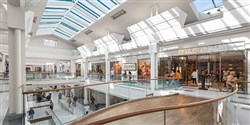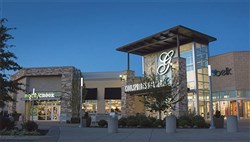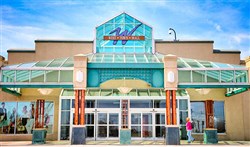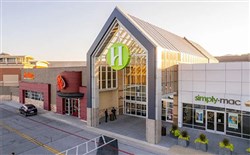VOL. 48 | NO. 23 | Friday, June 7, 2024
Survival of the glitziest
By Joe Morris
A half-century after its opening, Knoxville’s West Town Mall continues to adapt, evolve and thrive. A mere 14 miles to the east, its younger competitor East Towne Mall, later re-christened Knoxville Center, is but a memory.
Both had big-name anchor tenants, a bustling set of food vendors, the occasional pop-music icon tour stop, all the things deemed essential for a mall, at least in the 1980s. Why did one fail? And why is this pattern playing out in other Tennessee and U.S. cities? Depends on who you ask.
The rise, and reduced status, of the enclosed, galleria-style mall has generated many hot takes in the last couple of decades within the commercial real estate community.
It’s a landscape littered with husks. There were 2,500 mall locations in the United States in 1986. Now there are 700, and those numbers are still plunging, Business Insider reports.
Was it changing demographics? Displacement by online shopping? Economic woes in retail affecting the owners and landlords? There are sound arguments for each of these hypotheticals and others.
But first, the heyday. Going to the mall. For decades, this meant many different things, depending on the speaker and the year. By the 1980s, considered the mall’s golden era, a mall run could be a shopping trip or dinner and a movie. Same for teenagers, but also a chance to hang out with friends at the food court, arcade venues or just roam the vast expanse of corridors free of parental supervision.
From the late 1950s through the 1990s, enclosed malls were economic engines for their communities and their residents. And then, in cities and suburbs nationwide, the bottom fell out.
“The way people shop now is different than how they did it in the 1970s and 1980s,” says Jim Staley, managing broker of Wallace Real Estate in Knoxville, which recently celebrated the 88th anniversary. “Everyone is always looking for convenience, and the mall offered that. You could buy a gift for your kid, get lunch, then buy a suit and tie and, in some locations, even get a prescription filled and catch a movie.”
Now, he says, convenience has taken on a new meaning – home delivery.
“The experience of the mall can’t compete with home delivery, or even being able to drop by a strip center for an errand or two,” Staley says. “Malls just can’t compete with that, especially when shipping is offered at a discount or even free.”
Not too big to fail
Another contributing factor to a mall’s decline is sheer size. A dip in rent due to lost tenants, especially large or the all-important anchor ones, can be lethal to a property that has hundreds of thousands of square feet to heat, cool, insure and maintain.
“Malls have relied on anchor tenants, and those anchors are gone, or just not providing what the shoppers want to buy,” Staley says. “Where they are, you can see the difference. West Town has Dick’s House of Sport (the concept store offshoot of Dick’s Sporting Goods), which offers an experience as well as a place to shop thanks to a rock-climbing wall and some outdoor activities. Some sites have something like a Dave & Buster’s, which again is bringing people in to bowl, play games, eat, whatever.”
The mall landscapes in Chattanooga and Nashville have similar nuances to that of Knoxville, adds Brad Smith, an executive director in Cushman & Wakefield’s Atlanta office and a Knoxville native.
“You’re often talking about a two-mall market, although Nashville has more than that,” Smith says. “But regardless of the number, every property has its own unique characteristics that can take it from success to not doing well, or vice versa, over time.”
The numbers don’t lie
A mall isn’t exactly portable, so if one is built in an area that declines economically or in terms of easy accessibility, that’s also fatal. East Towne had some strikes against it from the outset, Staley says, that worsened over time.
“It just didn’t have the traffic count,” he explains. “It never did. West Town is surrounded by four-lane roads on every side and is just off an exit from I-40/I-75, where drivers can see it.”
He quotes transportation figures showing about 279,303 cars per day going by West Town, including about 214,000 on the interstate, to make his point.
“Not all of them are shoppers, but if you’ve been by there at Christmas, you can see those backed-up exits.”
East Towne, however, was reachable off I-640 but it took a few more turns along North Mall Road or Millerstown Pike to get to its parking lots. Its drive-by traffic runs about 94,473 per day, Staley says. “A big enough difference to be a problem, because those traffic counts tie into eyeballs on retail sites or lack of them.”
It’s why, he says, West Town-adjacent commercial real estate commands high rents and purchase prices, sometimes nearly $2 million an acre. While some outlying parcels sprung up around East Towne, and some are still going concerns, it’s a greatly reduced scale.

The Mall at Green Hills has been able to ensure its success by attracting high-end retailers.
-- Photographs ProvidedThere’s also the shoppers themselves. In 2023, West Town, had 126,025 residents in a five-mile radius, Staley says. “That figure was 102,353 for East Towne, a drop of almost 25,000 people available to come shopping. Median household income was just over $76,000 out west compared to just over $49,000 in the east, another blocker.
“That’s a big difference in people and in disposable income,” he says. “It makes it harder for a place to hold on when it begins to lose ground in terms of tenants and other factors.”
“Knoxville just wasn’t a two-mall town,” concludes Smith. “East Towne was viable from its opening through the early 2000s, but then it began to show a lot of weaknesses from an occupancy standpoint. You saw anchors closing or being replaced. The market there was just not large enough to support a mall of that size.”
To illustrate the city’s vibrancy out west, he options to the behemoth Turkey Creek development, which recreated the indoor mall experience on a larger, open-air footprint. It’s growth, while it may have competed with West Town, did not doom it.
“What Turkey Creek did was shift retail dominance in Knoxville further to the West and solidified a more affluent shopper base,” Smith says. “East Town couldn’t get those stores back, and it began to slip. And once you begin to slip, especially when you lose an anchor and that store pops up somewhere else in town, it’s hard to turn that around.”

CoolSprings Galleria is thriving, as is The Mall at Green Hills and others that cater to higher-income customers.
-- Photo ProvidedOther malls have taken sold off outlying properties, such as stand-alone movie theaters, to be redeveloped. That has helped boost traffic, as has changing some smaller stores facing inward to be larger, outward-facing destinations such as a Cheesecake Factory.
Even now, a successful mall can insulate its future by drawing in a high-visibility tenant as a Nordstrom, which Nashville’s Mall at Green Hills did a few years back, Smith adds.
“In many markets, even if there’s only one mall, you have them working to bring in someone like Apple or Tesla,” he says. “Those types of retailers are going to be very selective about where they go, and that can solidify the status of a mall as the dominant retailer. “
Two malls, different outcome
A similar story has unfolded in Chattanooga, where Hamilton Place and Northgate malls have spent decades battling for shoppers. These days, Smith says, Hamilton Place might be faring better thanks to tenants with strong drawing power.
“I knew they’d redeveloped the movie theaters there, something we’ve seen at other malls,” he says. “You also see things like taking a Sears anchor site and turning it into a Dick’s location or a Dave & Buster’s. You can split that old big box, redo some out-parcels, and get a lot more mileage out of the site.”

West Town Mall in Knoxville has what East Town Mall didn’t: a denser, wealthier population.
-- Photograph ProvidedNorthgate, he says, may be hampered by a different mix of offerings, but it still has plenty to recommend it to shoppers.
“They’re still in a good location, and when you’ve got lots of acres of land in town you can come up with a few long-term prospects if you need to reinvent yourself. It’s just a matter of working through what the highest and best use of the property would be,” he says.
Nashville’s success
In Nashville, the venerable Mall at Green Hills continues to reinvent itself, bringing in such crowd-pleasers at The Cheesecake Factory while also keeping a strong retail component in high-end retailers of varying sizes. Just south in Williamson County, CoolSprings Galleria also continues to be a shopping destination, thanks to its site just off Interstate 65 amid a continually growing array of strip malls, office complexes and housing communities.
“Green Hills knows how to set itself apart,” Smith says. “When you secure names like Apple or Tiffany’s, you set yourself apart. Then you get something like Nordstrom, and you’re housing the only one in Tennessee at the time.
“That’s drawing power, no matter what type of building you’re operating. It expands their reach and solidifies their market strength.”
And then there’s Opry Mills, which opened to much fanfare in the early 2000s as an outlet destination and has seen its fortunes rise and fall ever since, most notably after the 2010 floods shuttered it for months.
Farther north, there’s the Rivergate Mall, which has emptied over the years and is for sale (see sidebar), even as its footprint has seen the recent addition of emerging warehouse power BJ’s Wholesale Club.

Hamilton Place Mall in Chattanooga is faring better than Northgate Mall thanks to tenants that are more popular.
-- Photograph Provided“Renovation is a thing, whether it’s former big-box department stores or smaller spaces,” Smith says. “And a lot of these sites have co-tenancy clauses, which means that if two or more of the anchors go away, the smaller tenants have a way out of their leases triggered after a certain period. That can lead to a round of exits, which triggers another set of co-tenancy clauses and a real death spiral.”
Creative, adaptive, non-retail
Smith and Staley both point out that some malls might get a new lease on life as – not malls. Some owners and developers are thinking way outside the big box, turning the spaces into everything from satellite campuses for community colleges to multifamily housing and even hotels.
In the Nashville market, he calls out the 100 Oaks reuse by Vanderbilt University as a medical-office hub upstairs – while keeping retail units on the ground floor – as one idea that might happen in Tennessee before other uses are considered.
“We haven’t seen that type of hospitality rebuild in Tennessee yet, but it’s happening in other markets,” he says. “In Atlanta, they put an apartment complex in the parking lot of the former Sears site, so it’s something we may yet see in Tennessee.”
Still, Smith cautions, not every proposed idea can take the place of what a mall did, and it’s about more than just people passing through the doors.
“New construction is costly, and even with the kind of open floor plan you have in an anchor retail space, you’ve got to retrofit it to the new needs,” he says. “We’ve seen call centers, trade schools and community colleges, which have worked, but those are also more of a five-day, business-hours use. The hours people are on the site are limited, no nights and weekends for the most part.
“That’s not doing much for the areas around the site. If you get something in there like multifamily housing, on the other hand, that might do more, because those people are going to leave the site to shop and dine more frequently than a student or office worker, for example.”
The future of malls
The challenge for the surviving malls in Nashville, Knoxville and Chattanooga going forward will be to keep the anchors, whoever they are, happy and in place, Smith says, adding that if they stay put, the smaller retailers likely will also.
“Losing an anchor is tough, even if you are doing well,” he says. “It’s a loss of income, it doesn’t look good. Then you’ve got to figure out what to do with that property. Some malls are consolidating down, demolishing an empty big-box space and filling that with other uses. Or they are doing medical and/or multifamily. Some are also looking at more back-office users, a call center or a company that needs a place to put other kinds of workers. The options are there, but they’d rather keep it going as a retail operation.”
“When the anchors begin losing customers to online shopping or another venue, it hurts the little guys around them,” Staley says. “People aren’t going to go to a mall just to get an Auntie Anne’s pretzel. Shopping patterns, locations, demographics … retail is always a puzzle, and it’s not an easy one.
“What’s happening is sad, really. At one time malls were a blast, both to go to and for the people that owned them. Now that’s just not an experience people are after.”